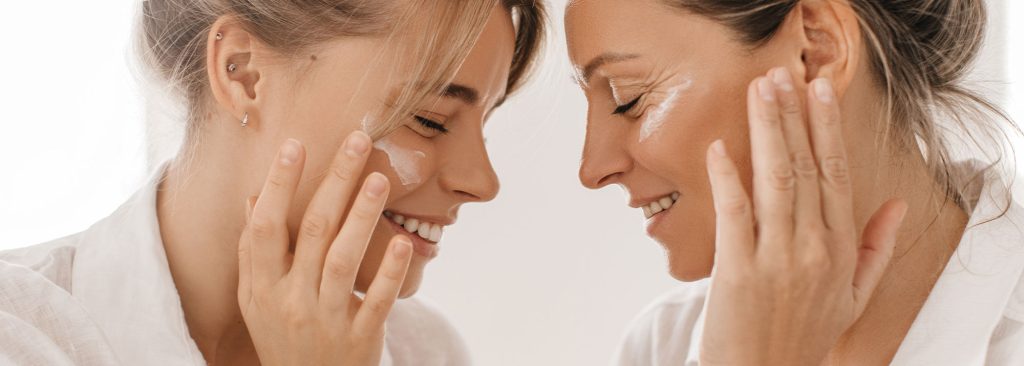Use Sunscreens This Summer But Choose Wisely
Be Careful What Ingredients You Put On and Into Your Body
by Greg Maguire, PH.D. – NeoGenesis Co-Founder & Chief Scientific Officer
Chemicals in sunscreen can penetrate the skin and become systemic. It’s important to understand why and how you should choose your sunscreen carefully. Toxic chemicals, such as PFAS and Benzene have been found in certain sunscreen products. Sunscreens are important to keep the skin safe from exposure to damaging UV irradiation, something that increases the odds of skin cancer.
The Importance of Non-Toxic Sunscreen
To keep the skin safe, reapplying sunscreen is recommended every 2 hours when out in the sun. This means that sunscreen stays in contact with skin over a long period of time. When products are applied to the skin, especially so-called leave-on products, your skin has long term exposure to the ingredients in the product. Many of the ingredients can absorb into the skin, and some of the ingredients may have negative effects. Careful choice of a product based on its ingredients is therefore critical to your health.
Sun Exposure and Melanoma
Sunscreen use has been found to reduce the risk of melanoma. The most aggressive form of skin cancer is melanoma, arising when pigment-producing skin cells, called melanocytes, become cancerous in a state of uncontrolled proliferation. Melanoma is becoming more common every year. While people with dark skin are less likely to have melanoma, if they do develop melanoma their outcomes will be worse than those with lighter skin. Studies have found that exposure to ultraviolet (UV) radiation from the sun increases your risk of melanoma, especially if you had sunburns during childhood. Melanoma is distinct from non-melanoma skin cancers in that it tends to spread locally, regionally, and distantly. Once melanoma cells are formed in the skin, the melanoma cells send out messages that change the surrounding lymph tissue such that the lymph becomes more permissible to the spread of the melanoma cells to other parts of the body. An individual’s risk of metastasis (spread of the cancer) is directly related to the depth of invasion and ulceration of their primary lesion. This alone is why sunscreens are so important.
Broad-Spectrum UV Protection
UV irradiation also causes oxidative damage in cells due to the release of inflammatory cytokines that in turn generate reactive oxygen species (ROS), damaging lipids, proteins and DNA. Premature aging of the skin results, with coincident inflammation.
A recent report from the Environmental Working Group (EWG), a non-profit in the US, found that only 25 percent of the 1,700 SPF products reviewed offer good broad-spectrum protection without troubling ingredients. Many of the products don’t effectively block the damaging UV incident on the skin, and many contain ingredients that are harmful, such as oxybenzone (aka benzophenone-3). This ingredient is known as a chemical sunscreen as opposed to a physical block sunscreen.
Mineral sunscreens, which are physical block sunscreens that absorb UV, are composed of the minerals zinc oxide and titanium dioxide.
The mineral sunscreens use small particles that sit on the skin’s surface and physically prevent UV rays from penetrating the skin. Chemical sunscreens work differently, allowing UV radiation into the skin. Once the UV is absorbed into the skin, the chemicals in the sunscreen, such as oxybenzone, avobenzone, octisalate, octocrylene, homosalate, and octinoxate, create a chemical reaction in which UV radiation is converted to heat, and the heat dissipates from the skin.
A Brief History on Sunscreen Scientific Research
In 1997, a study in the Lancet found that substantial amounts of an applied sunscreen, oxybenzone, were absorbed and subsequently excreted in human urine. Although oxybenzone has low acute toxicity in animal studies, little is known about its chronic toxicity and disposition after topical application in people. A small randomized clinical trial published in May 2019 in the Journal of the American Medical Association (JAMA) found that four of the chemical sunscreens (avobenzone, oxybenzone, octocrylene, and ecamsule) were absorbed into the bloodstream at significantly greater levels than 0.5 nanograms per milliliter (ng/mL).
That level of these chemicals is far above the amount at which the FDA requires topical medications that also use these chemicals to undergo safety studies to determine possible toxic effects. In other words, FDA approved drugs are being more carefully monitored for these toxic ingredients than are sunscreens.
Sun care products that use physical sunscreens instead of chemical sunscreens limit exposure to ingredients such as avobenzone are also the better choice because the chemical sunscreen ingredients cause allergic skin reactions , behave like a hormone disruptor in many studies, and may cause more harm to children.
Look for products that contain the physical UV blockers such as the minerals titanium dioxide and zinc oxide in a non-spray format. When in an aerosol spray, the product may also contain benzene, a powerful carcinogen and hematotoxin.
It’s important to understand that it is the totality of your exposures that will be harmful. We are bombarded with thousands of chemicals daily. The combination of chemical exposures is not understood. What is understood, very well, is that the increased exposure to chemical is leading to the rapid rise of diseases, and our exposome accounts for about 90% of all diseases.
The real world studies are done in people with normal exposure to other chemicals and therefore better reflect a combination of exposures than do the clinical trials. How many times have I heard that “randomized control trials, considered the gold standard in research” are the way to understand something. I disagree. Most of what we know about the universe, whether it is physics, chemistry, or biology is through observational studies. This is also true of FDA approved drugs. By using careful observation by those who don’t have conflicts of interest, much can be learned.
The chemical sunscreens are also damaging to marine life, including our beautiful and life sustaining reefs, including the coral Galaxea fascicularis, and have been banned for use in jurisdictions such as Hawaii (first in nation) and Key West, FL. As with sunscreen and drug exposures in humans, sunscreen exposure to marine life is only one of many toxic chemical exposures that may be killing our coral reefs. The National Academy of Sciences discusses it here, and their headline is: “Without a doubt, a variety of compounds present in the mixture of chemical pollution entering our environments are a contributing cause of ecological decline.” Let’s refrain from oversimplifying our understanding of these issues related to chemical exposure.
PFAS (Forever Chemicals)
PFAS, a long lasting chemical found in many sunscreens, has been banned in cosmetics by California (first in the nation). PFAS do not naturally exit the body for many months or many years and are not known to degrade in the environment, they are considered “forever chemicals.” Widespread human exposure to PFAS in water, food, and air coupled with the lengthy environmental persistence and biological half-lives of months to years for some PFAS have led to measurable PFAS in the blood of nearly the entire population in developed countries, with health effects reported globally.
While much work has provided evidence that these PFAS chemicals are damaging, more studies are required to better understand what can be done to mitigate their effects, especially given they remain in our environment for decades. Therefore, it’s imperative to reduce the amount of PFAS you are exposed to by food, water, and topical care products. Be aware that the damaging effects may be more severe in children given their brain, immune system, and other organs are developing in a rapid manner where toxic chemicals may interfere with developmental signaling molecules in the child’s organs.
In conclusion, it is clear that the sun care products we use matter, not only to our personal health but also to the environment. Embracing mineral sunscreens that use ingredients like zinc oxide and titanium dioxide can help us reduce exposure to potentially harmful chemicals. Moreover, it’s crucial to advocate for more stringent regulations and safety studies in the sunscreen industry to ensure that all products on the market are safe for consumers and the environment. The chemicals we interact with daily have far-reaching implications, making it essential to be informed and make conscious choices for our health, the health of future generations, and the well-being of our planet.
Do you want to learn more about what NeoGenesis products can do for you? Follow NeoGenesis on Facebook, Instagram, TikTok, LinkedIn and YouTube.
 San Diego, CA 92121
San Diego, CA 92121
858) 751-4714
www.NeoGenesis.com
info@neogenesis.com
Be Careful What Ingredients You Put On and Into Your Body
by Greg Maguire, PH.D. – NeoGenesis Co-Founder & Chief Scientific Officer
Chemicals in sunscreen can penetrate the skin and become systemic. It’s important to understand why and how you should choose your sunscreen carefully. Toxic chemicals, such as PFAS and Benzene have been found in certain sunscreen products. Sunscreens are important to keep the skin safe from exposure to damaging UV irradiation, something that increases the odds of skin cancer.
The Importance of Non-Toxic Sunscreen
To keep the skin safe, reapplying sunscreen is recommended every 2 hours when out in the sun. This means that sunscreen stays in contact with skin over a long period of time. When products are applied to the skin, especially so-called leave-on products, your skin has long term exposure to the ingredients in the product. Many of the ingredients can absorb into the skin, and some of the ingredients may have negative effects. Careful choice of a product based on its ingredients is therefore critical to your health.
Sun Exposure and Melanoma
Sunscreen use has been found to reduce the risk of melanoma. The most aggressive form of skin cancer is melanoma, arising when pigment-producing skin cells, called melanocytes, become cancerous in a state of uncontrolled proliferation. Melanoma is becoming more common every year. While people with dark skin are less likely to have melanoma, if they do develop melanoma their outcomes will be worse than those with lighter skin. Studies have found that exposure to ultraviolet (UV) radiation from the sun increases your risk of melanoma, especially if you had sunburns during childhood. Melanoma is distinct from non-melanoma skin cancers in that it tends to spread locally, regionally, and distantly. Once melanoma cells are formed in the skin, the melanoma cells send out messages that change the surrounding lymph tissue such that the lymph becomes more permissible to the spread of the melanoma cells to other parts of the body. An individual’s risk of metastasis (spread of the cancer) is directly related to the depth of invasion and ulceration of their primary lesion. This alone is why sunscreens are so important.
Broad-Spectrum UV Protection
UV irradiation also causes oxidative damage in cells due to the release of inflammatory cytokines that in turn generate reactive oxygen species (ROS), damaging lipids, proteins and DNA. Premature aging of the skin results, with coincident inflammation.
A recent report from the Environmental Working Group (EWG), a non-profit in the US, found that only 25 percent of the 1,700 SPF products reviewed offer good broad-spectrum protection without troubling ingredients. Many of the products don’t effectively block the damaging UV incident on the skin, and many contain ingredients that are harmful, such as oxybenzone (aka benzophenone-3). This ingredient is known as a chemical sunscreen as opposed to a physical block sunscreen.
Mineral sunscreens, which are physical block sunscreens that absorb UV, are composed of the minerals zinc oxide and titanium dioxide.
The mineral sunscreens use small particles that sit on the skin’s surface and physically prevent UV rays from penetrating the skin. Chemical sunscreens work differently, allowing UV radiation into the skin. Once the UV is absorbed into the skin, the chemicals in the sunscreen, such as oxybenzone, avobenzone, octisalate, octocrylene, homosalate, and octinoxate, create a chemical reaction in which UV radiation is converted to heat, and the heat dissipates from the skin.
A Brief History on Sunscreen Scientific Research
In 1997, a study in the Lancet found that substantial amounts of an applied sunscreen, oxybenzone, were absorbed and subsequently excreted in human urine. Although oxybenzone has low acute toxicity in animal studies, little is known about its chronic toxicity and disposition after topical application in people. A small randomized clinical trial published in May 2019 in the Journal of the American Medical Association (JAMA) found that four of the chemical sunscreens (avobenzone, oxybenzone, octocrylene, and ecamsule) were absorbed into the bloodstream at significantly greater levels than 0.5 nanograms per milliliter (ng/mL).
That level of these chemicals is far above the amount at which the FDA requires topical medications that also use these chemicals to undergo safety studies to determine possible toxic effects. In other words, FDA approved drugs are being more carefully monitored for these toxic ingredients than are sunscreens.
Sun care products that use physical sunscreens instead of chemical sunscreens limit exposure to ingredients such as avobenzone are also the better choice because the chemical sunscreen ingredients cause allergic skin reactions , behave like a hormone disruptor in many studies, and may cause more harm to children.
Look for products that contain the physical UV blockers such as the minerals titanium dioxide and zinc oxide in a non-spray format. When in an aerosol spray, the product may also contain benzene, a powerful carcinogen and hematotoxin.
It’s important to understand that it is the totality of your exposures that will be harmful. We are bombarded with thousands of chemicals daily. The combination of chemical exposures is not understood. What is understood, very well, is that the increased exposure to chemical is leading to the rapid rise of diseases, and our exposome accounts for about 90% of all diseases.
The real world studies are done in people with normal exposure to other chemicals and therefore better reflect a combination of exposures than do the clinical trials. How many times have I heard that “randomized control trials, considered the gold standard in research” are the way to understand something. I disagree. Most of what we know about the universe, whether it is physics, chemistry, or biology is through observational studies. This is also true of FDA approved drugs. By using careful observation by those who don’t have conflicts of interest, much can be learned.
The chemical sunscreens are also damaging to marine life, including our beautiful and life sustaining reefs, including the coral Galaxea fascicularis, and have been banned for use in jurisdictions such as Hawaii (first in nation) and Key West, FL. As with sunscreen and drug exposures in humans, sunscreen exposure to marine life is only one of many toxic chemical exposures that may be killing our coral reefs. The National Academy of Sciences discusses it here, and their headline is: “Without a doubt, a variety of compounds present in the mixture of chemical pollution entering our environments are a contributing cause of ecological decline.” Let’s refrain from oversimplifying our understanding of these issues related to chemical exposure.
PFAS (Forever Chemicals)
PFAS, a long lasting chemical found in many sunscreens, has been banned in cosmetics by California (first in the nation). PFAS do not naturally exit the body for many months or many years and are not known to degrade in the environment, they are considered “forever chemicals.” Widespread human exposure to PFAS in water, food, and air coupled with the lengthy environmental persistence and biological half-lives of months to years for some PFAS have led to measurable PFAS in the blood of nearly the entire population in developed countries, with health effects reported globally.
While much work has provided evidence that these PFAS chemicals are damaging, more studies are required to better understand what can be done to mitigate their effects, especially given they remain in our environment for decades. Therefore, it’s imperative to reduce the amount of PFAS you are exposed to by food, water, and topical care products. Be aware that the damaging effects may be more severe in children given their brain, immune system, and other organs are developing in a rapid manner where toxic chemicals may interfere with developmental signaling molecules in the child’s organs.
In conclusion, it is clear that the sun care products we use matter, not only to our personal health but also to the environment. Embracing mineral sunscreens that use ingredients like zinc oxide and titanium dioxide can help us reduce exposure to potentially harmful chemicals. Moreover, it’s crucial to advocate for more stringent regulations and safety studies in the sunscreen industry to ensure that all products on the market are safe for consumers and the environment. The chemicals we interact with daily have far-reaching implications, making it essential to be informed and make conscious choices for our health, the health of future generations, and the well-being of our planet.
Do you want to learn more about what NeoGenesis products can do for you? Follow NeoGenesis on Facebook, Instagram, TikTok, LinkedIn and YouTube.






